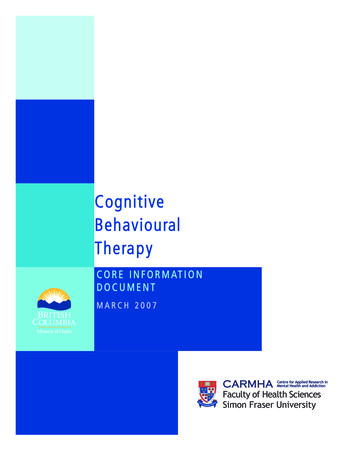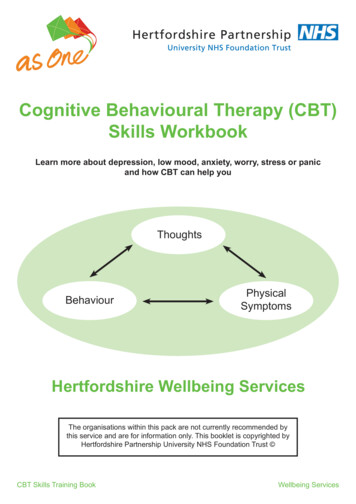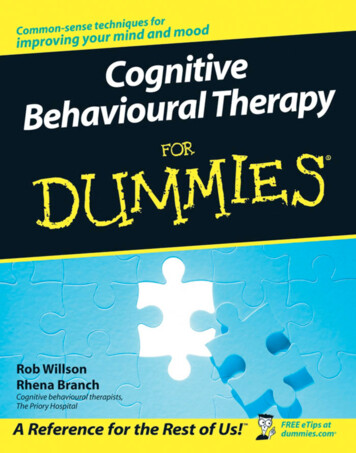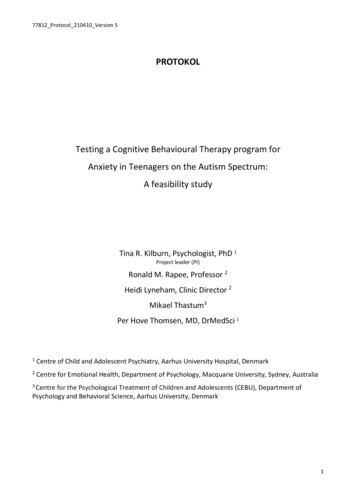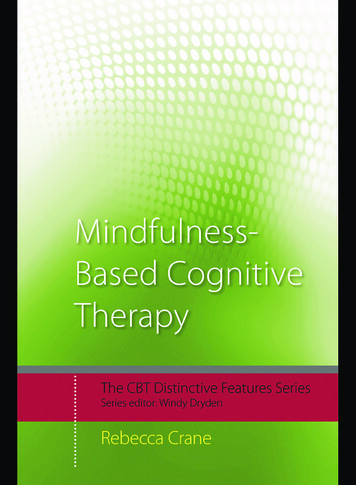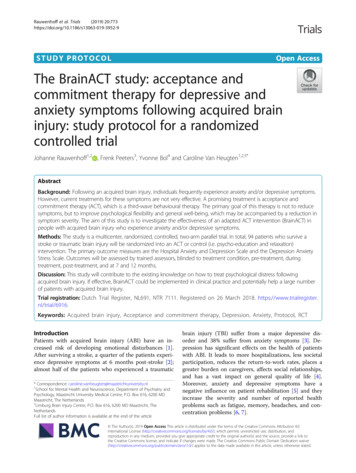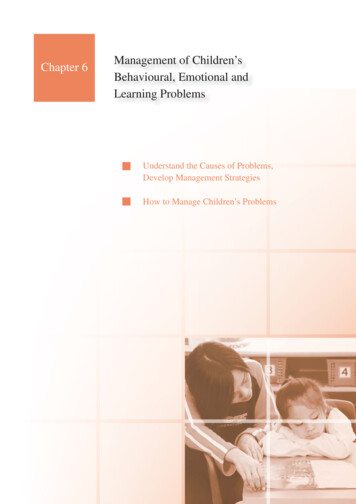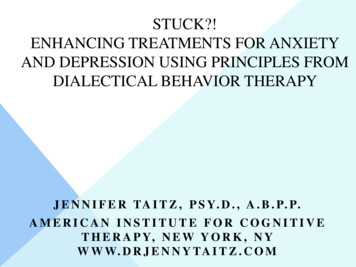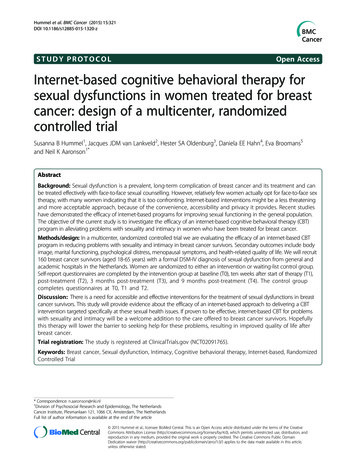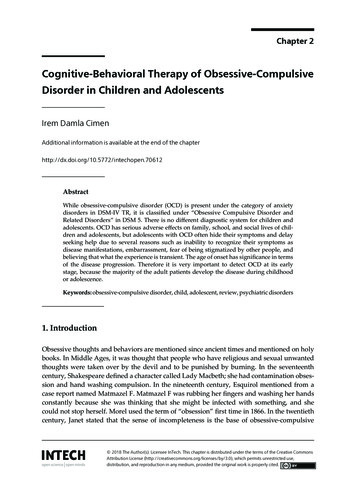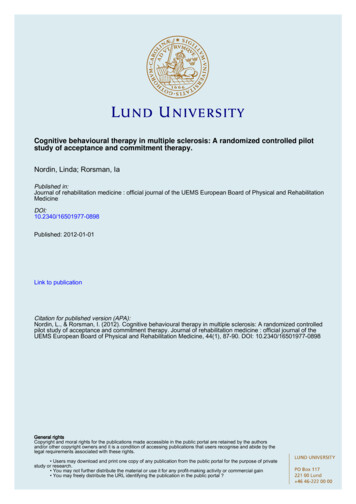
Transcription
Cognitive behavioural therapy in multiple sclerosis: A randomized controlled pilotstudy of acceptance and commitment therapy.Nordin, Linda; Rorsman, IaPublished in:Journal of rehabilitation medicine : official journal of the UEMS European Board of Physical and lished: 2012-01-01Link to publicationCitation for published version (APA):Nordin, L., & Rorsman, I. (2012). Cognitive behavioural therapy in multiple sclerosis: A randomized controlledpilot study of acceptance and commitment therapy. Journal of rehabilitation medicine : official journal of theUEMS European Board of Physical and Rehabilitation Medicine, 44(1), 87-90. DOI: 10.2340/16501977-0898General rightsCopyright and moral rights for the publications made accessible in the public portal are retained by the authorsand/or other copyright owners and it is a condition of accessing publications that users recognise and abide by thelegal requirements associated with these rights. Users may download and print one copy of any publication from the public portal for the purpose of privatestudy or research. You may not further distribute the material or use it for any profit-making activity or commercial gain You may freely distribute the URL identifying the publication in the public portal ?LUNDUNIVERSITYPO Box11722100Lund 46462220000
J Rehabil Med 2012; 44: 87–90Short CommunicationCognitive behavioural therapy in multiple sclerosis:A randomized controlled pilot study oF Acceptance andCommitment TherapyLinda Nordin, MSc1,2 and Ia Rorsman, PhD1From the 1Department of Neurology, Skane University Hospital – Lund, Lund, Sweden and 2Rehabilitation andResearch Centre for Torture Victims, Copenhagen K, DenmarkObjective: The aim of this study was to design a trial thatcould evaluate the effect of acceptance and commitmenttherapy as a group-intervention for multiple sclerosis patients with psychological distress.Design: Randomized controlled trial with assessment at pretreatment, end of treatment, and at 3-month follow-up.Subjects: Multiple sclerosis outpatients with elevated symptoms of anxiety and/or depression (n 21).Methods: Patients were randomly assigned to acceptanceand commitment therapy or relaxation training. Both treatments consisted of 5 sessions over 15 weeks containing didactic sessions, group discussions, and exercises. Outcome wasassessed by self-rated symptoms of anxiety, depression, anda measure of acceptance.Results: At 3-month follow-up, the relaxation training grouphad a significant decline in anxiety symptoms whereas theacceptance and commitment therapy group showed a maintained improvement in rated acceptance at follow-up.Conclusion: The results reflect the different emphases of thetherapies. Acceptance and commitment therapy is aimed atliving an active, valued life and increasing acceptance, whilerelaxation training focuses directly on coping strategies tohandle emotional symptoms. The results are preliminary,but supportive of further study of brief group interventionsfor reducing psychological distress in patients with multiplesclerosis.Key words: multiple sclerosis; cognitive behaviour therapy;relaxation therapy; psychotherapy; group.J Rehabil Med 2012; 44: 87–90Correspondence address: Ia Rorsman, Department of Neuro logy, Skane University Hospital – Lund, SE-221 85 Lund,Sweden. E-mail: Ia.Rorsman@med.lu.seSubmitted April 27, 2011; accepted August 30, 2011INTRODUCTIONMultiple sclerosis (MS), one of the most common neurologicaldisorders, is a chronic inflammatory demyelinizing diseasethat affects the central nervous system. Symptoms vary widelyand can affect visual, motor, sensory, coordination, balance,bowel, bladder and sexual functioning. Symptoms of anxietyand depression are common, and linked to social dysfunction, decreased adherence to treatment, somatic complaintsand lower functional status (1). In a Cochrane review from2007 it was concluded that the scope for using psychologicalinterventions in MS is broad, while the evidence-base is stillrelatively small (2). However, there is reasonable evidencethat cognitive behavioural therapy (CBT) is beneficial in thetreatment of depression, and in helping people adjust to, andcope with, having MS (2).Acceptance and commitment therapy (ACT) is a modernCBT approach, designed to improve functioning and qualityof life by increasing a person’s ability to stay active and act inconcordance with personally held values (3). The approach alsoincludes practice in mindfulness and acceptance. Overall, theeffects of ACT look promising (large effect size compared withwaitlist conditions, and moderate effect size compared withtreatment-as-usual or other active treatment) although furtherstudies are needed in which ACT is compared with empiricallysupported treatments (4, 5). One uncontrolled study has shownencouraging results on ACT and MS (6).The aim of this pilot trial was to design a study that, in a largerfollow-up study, could evaluate the effect of ACT as a groupintervention for MS outpatients with anxiety and/or depression.ACT is a brief intervention (manuals with as little as 3 sessions),which gives cost benefits and enables implementation in outpatient settings (7). ACT was compared in a randomized controlledtrial with relaxation training (RT), a behavioural interventionthat previously has been successfully applied on patients withMS (8). RT is a commonly used component of CBT and, giventhe extensive data in support of its efficacy, is often comparedwith other psychological methods (9, 10).METHODSSubjectsTwenty-one adult patients with MS (Fig. 1), according to McDonaldcriteria, were included after obtaining informed consent. Patients withno to moderate functional disability ( 6.0 on the Expanded DisabilityStatus Scale; EDSS) (11), who were referred by their doctor as having difficulties coping/adjusting to their disorder were recruited fromthe Department of Neurology, Lund University Hospital, Sweden, inMarch 2008. Invitation to participate was sent to patients with elevatedsymptoms of anxiety and/or depression ( 10 on the Beck DepressionInventory (BDI) (12), and/or 8 on one or both of the subscales ofHospital Anxiety and Depression Scale (HADS) (13)). Patients witha history of serious psychiatric illness or current alcohol or substanceabuse were excluded. 2012 The Authors. doi: 10.2340/16501977-0898Journal Compilation 2012 Foundation of Rehabilitation Information. ISSN 1650-1977J Rehabil Med 44
88L. Nordin and I. Rorsman multiple sclerosisReferred: n 22,Referred by MD, at the Department ofNeurology, Lund University Hospital,Sweden, in March, 2008.Criteria:-EDSS 6.0- Perceived difficultiesACT group RT groupBaseline characteristics and outcome data (n 11)(n 10)coping/adjusting to MSExcluded (n 1)- Not meetinginclusion criteriadepression and/oranxietyPre-treatment assessment:n 2214–30 days prior to treatmentRandomized: n 21RT-session 1 (n 10)ACT-session 1 (n 11)1 week in-betweenRT-session 2 (n 10)ACT-session 2 (n 10)1 week in-betweenACT-session 3 (n 10)RT-session 3 conductedindividually over telephone(n 10)1 week in-betweenACT-session 4 (n 10)RT-session 4 (n 10)11 weeks in-betweenACT-session 5 (n 10)RT-session (n 10) Post-treatment assessment(n 10) Post-treatment assessment(n 10)Discontinued intervention(withdrew at own requestafter first session) (n 1)Discontinued intervention(n 0)12 weeks in-betweenFollow-up assessment bypost (n 10)Follow-up assessment bypost (n 10)Fig. 1. Treatment flow. EDSS: Expanded Disability Status Scale; MS:multiple sclerosis; ACT: Acceptance and commitment therapy; RT:relaxation training.ProcedurePatients were randomly assigned by an independent co-worker to oneof two treatment groups following pairwise matching based on EDSS,anxiety, and depression scores. Both programmes, ACT and RT, werelargely based on previously published manuals (3, 7, 14, 15). Treatments contained didactic sessions, group discussions, and exercises.The ACT intervention is based on 6 core processes: defusion, acceptance, mindfulness, values, self as context and committed action(3). For the ACT group, the first session focused on didactic andexperiential reflections of avoidance and control strategies and thelong-term costs and consequences of these. Sessions 2 and 3 focusedon mindfulness, acceptance, and cognitive defusion techniques asalternatives. In session 4, patients explored personally held valuesand how to live life in accordance with these. At the 3-month boosterfollow-up these strategies were rehearsed.For the RT group, the rationale of RT was explained in session 1.In sessions 1–3, the relaxation training was presented and practicedin a step-wise fashion in accordance with the manual (14). Session 4was an individual session over the telephone in which each participantreceived personal guidance on how to carry out the programme. Atthe 3-month booster follow-up, the programme was rehearsed. Theprotocols (in Swedish) are available on request.RT is normally given as a 10-week session treatment. To match thebenefits of the short-term ACT therapy, RT had to be shortened to a5-session design (15). Both groups received home exercises and CDscontaining audio versions of the relaxation techniques (RT group) andmindfulness exercises (ACT group).Both interventions were given by the authors of this paper, who arepsychologists working at the clinic. One author has extensive experienceJ Rehabil Med 44Table I. Baseline characteristics and outcome data on patients randomizedto acceptance and commitment therapy (ACT) and relaxation training(RT)Age, years, median (IQR)Marital status, married/cohabitant, nEDSS, median (IQR)Length of illness, years, median (IQR)Reported frequency of homeworkpractice, nDailyFew times a weekRarely–neverHADS-A, median (IQR)PretreatmentEnd of treatment3 months follow-upHADS-D, median (IQR)PretreatmentEnd of treatment3 months follow-upBDI, median (IQR)PretreatmentEnd of treatment3 months follow-upAAQ, median (IQR)PretreatmentEnd of treatment3 months follow-up43 (36–45)101 (1–2.5)5 (2–12)27148.5 (38–55)72 (1–3)9 (5–16)7†3†010 (7–15)10 (5–14)10 (6–13)9 (6–12)7.5 (5–12)6 (2–12)*5 (3–9)3 (3–11)5 (3–11)7 (6–9)4 (3–7)*†6.5 (2–10)13 (10–20)12 (9–19)*10 (7–25)15 (10.5–23)13.5 (7.5–17)11 (5–22)45 (38–49) 44.5 (41.5–49)49 (41–53)* 48.5 (37–62)52 (41–60)* 48 (41–58.5)†Between-group difference at p 0.05 (on outcome measures: based ondifference scores from pretreatment).*Within-group difference at p 0.05 compared with pre-treatment. Scoreson HADS-A and HADS-D range from 0 to 21. BDI ranges from 0 to63. AAQ-II ranges from 10 to 70, with higher scores representing morepsychological acceptance.IQR: interquartile range; HADS-D: Hospital Anxiety and DepressionScale-Depression Scale; HADS-A: Hospital Anxiety and DepressionScale-Anxiety Scale; BDI: Beck Depression Inventory; AAQ: Acceptanceand Action Questionnaire.in RT and some ACT training (5 days). The other has extensive training in ACT and teaches ACT for licensed psychologists at the SwedishPsychological Association’s cooperation for continuing education.AssessmentThe following outcome measures were used: HADS; BDI; Acceptanceand Action Questionnaire (AAQ-II) (16). AAQ-II assesses the abilityto accept undesirable thoughts and feelings. Any changes in treatmentplan or relapses were recorded from the patient’s journal. Patient’sexpectations vs credibility of treatment was recorded after the firstsession and at the end of treatment, respectively (17).All treatment effect analyses were by intention-to-treat. For participants who dropped out, scores from the previous assessment werecarried forward. Scoring and data analyses were conducted blindly.Between-group comparisons on patient background characteristicswere conducted with Mann-Whitney U tests and χ2 analyses. Groupcomparisons in changes on outcome variables were assessed usingMann-Whitney U analyses on difference scores. On each variable, twodifference scores were calculated (pre-treatment to post treatment; pretreatment to follow-up). Within-group comparisons to pre-treatmentscores were calculated with a Wilcoxon signed-rank test for eachtreatment group. Two-tailed tests were used in all analyses.
Acceptance and commitment therapy in multiple sclerosisRESULTSA total of 20 patients (8 women in each group) completed thetreatment. There were no significant differences at randomization between the 2 treatment groups with regard to age, lengthof illness, gender, marital status, occupational status, EDSS,or pre-treatment outcome data. Background information ispresented in Table I.The majority of patients had relapsing remitting MS,whereas 5 patients (2 in ACT and 3 in the RT group) werediagnosed with secondary progressive MS. All patients, except patients with secondary progressive MS, were receivingimmunomodulary medication. None of the patients receivednatalizumab. Two patients (one from each group) had changesin immunomodulating treatment during follow-up. One patientfrom each group had ongoing psychotherapeutic contacts. Psychopharmacological medication included selective serotoninre-uptake inhibitors (3 patients in each group) and lamotrigine(one from ACT, two from the RT group). Two patients from theACT group and 3 from the RT group were on full-time sick pay,the remaining patients were employed or in education.One patient (RT group) had a MS relapse with complete recovery during treatment. Expectations of treatment after the firstsession did not differ between groups (8/11 patients in ACT and7/10 in the RT group believed treatment would, or, was likelyto, help). Credibility ratings were high at the end of treatment as90% in both groups responded would recommend treatment.All significant changes in outcome measures are presented inTable I. Between-group analyses on difference scores yieldeda significant outcome on Hospital Anxiety and DepressionScale-Depression Scale (HADS-D) scores, with the RT groupshowing a larger decline than the ACT group between pre- andpost-treatment (p 0.05). Patients in the RT group reporteda higher frequency of daily practice (χ2 5.9, p 0.05) thanthe ACT group. Within-subject contrasts in the RT groupshowed significant decrease in HADS-D between pre- andpost-treatment (Z 2,4, p 0.05) as well as a significant decline in Hospital Anxiety and Depression Scale-Anxiety Scale(HADS-A) from pre-treatment to follow-up (Z 1,9, p 0.05).Within-subject analyses in the ACT group yielded a significantdecline in BDI scores from pre-treatment to post-treatment(Z 2.2, p 0.05), as well as an increase (improvement) inAAQ-II scores from pre- to post-treatment (Z 2.2, p 0.05)and from pre-treatment to follow-up (Z 2.1, p 0.05).DISCUSSIONThe aim of this study was to conduct a pilot trial that compared ACT, a brief intervention aimed at enhancing acceptance rather than control of negative experiences, withRT, an approach using coping strategies to handle negativepsychological symptoms. Patients receiving RT showed alarger decline than the ACT group in depressive symptoms(HADS-D). However, this difference was not maintained at3-month follow-up. Moreover, and consistent with previousresearch (10, 18), within-group analysis of RT patients showed89a decline in anxiety symptoms (HADS-A) from pre-treatmentto follow-up. Although between-group comparisons did notdemonstrate any advantage to ACT over RT on any outcomevariable, within-group analyses on the ACT group showed aneffect on AAQ-II, assessing the ability to accept undesirablethoughts and feelings. Moreover, this result was maintainedat follow-up, 3 months after the end of treatment.These results mirror the different approaches of the twotherapies. ACT is aimed at helping the patient acceptingpsychological pain and leading life in accordance with personally held values, despite irreversable symtoms. RT, on theother hand, focuses directly on coping strategies to handledysfunctional psychological symptoms. Outcome variablesassessing aspects in quality of life, such as social and physicalparticipation and daily functioning may have been more appropriate than symptom scales given the breadth of difficultiesassociated with MS and the emphasis on behavioral changerather than symptom reduction in ACT.Inclusion of a wait-list control group would have helped toanswer whether any form of brief group intervention couldhave given the observed effects. In light of existing critisismof available research on ACT (4, 5), the importance of comparing ACT to previously empircally documented treatmentwas prioritized. Credibility ratings were high and did not differ between groups. The treatment groups differed, however,with regard to homework practice. The majority of RT patientsreported practicing daily whereas the majority of ACT patientsonly practiced a few times a week. This is likely to be a reflection of intrinsic differences in the treatment programmes wherethe importance of systematic daily practice is emphasized inRT, but less so in ACT. The ACT group was encouraged to integrate the ACT techniques in daily life. Given that homeworkcompliance can be a major obstacle for progress in RT, thiscan be considered an important advantage to ACT.This study has several weaknesses, most importantly the limit ed follow-up period, the absence of an independent treatmentevaluation to ensure treatment integrity, and the small number ofparticipants. Given these limitations, the results should be considered preliminary but supportive of further study of short-termCBT treatments for reducing psychological distress in patientswith MS. This pilot should be useful in designing such studies.The importance of continued research in this field is illustrated by studies suggesting that depression and anxiety appearto be undertreated in MS outpatient settings (1). Moreover,whereas clinicians have been found to be more concerned aboutthe physical manifestation of the disease, patients with MSconsider mental health to be a critical determinant of overallburden (19). Further focus on empirically proven psychotherapeutic interventions may help bridge this gap and improve theoverall quality of life for patients with MS.AcknowledgementsThe authors would like to thank the following co-workers for invaluablereferrals of patients to the present investigation: Gun Jadbäck, LenaAsmoarp, Karin Lennartsson, Petra Nilsson, and My Bergkvist.J Rehabil Med 44
90L. Nordin and I. Rorsman multiple sclerosisConflicts of interest: None to declare.Funding: Lindhaga Foundation, Sweden.10.REFERENCES1. Chwastiak LA, Ehde DM. Psychiatric issues in multiple sclerosis.Psychiatr Clin N Am 2007; 30: 803–817.2. Thomas PW, Thomas S, Hillier C, Galvin K, Baker R. Psychological interventions for multiple sclerosis. Cochrane Database SystRev 2006: CD004431.3. Hayes SC, Strosahl K, Wilson KG. Acceptance and commitmenttherapy: an experiential approach to behavior change. New York:Guilford; 1999.4. Ost LG. Efficacy of the third wave of behavioral therapies: asystematic review and meta-analysis. Behav Res Ther 2008; 46:296–321.5. Powers MB, Zum Vorde Sive Vording MB, Emmelkamp PM.Acceptance and commitment therapy: a meta-analytic review.Psychother Psychosom 2009; 78: 73–806. Sheppard SC, Forsyth JP, Hickling EJ, Bianchi JM. A novel application of acceptance and commitment therapy for psychosocialproblems associated with multiple sclerosis: Results from a halfday workshop intervention. Int J MS Care 2010; 12: 200–206.7. Bond FW. ACT for stress. In Hayes SC, Strosahl KD, editors. Apractical guide to acceptance and commitment therapy. New York:Springer-Verlag; 2005: 275–292.8. van Kessel K, Moss-Morris R, Willoughby E, Chalder T, JohnsonMH, Robinson E. A randomized controlled trial of cognitivebehavior therapy for multiple sclerosis fatigue. Psychosom Med2008; 70: 205–213.9. Twohig MP, Hayes SC, Plumb JC, Pruitt LD, Collins AB, Hazlett-J Rehabil Med 4411.12.13.14.15.16.17.18.19.Stevens H, et al. A randomized clinical trial of acceptance and commitment therapy versus progressive relaxation training for obsessivecompulsive disorder. J Consult Clin Psych 2010; 78: 705–716.Chambless DL, Ollendick TH. Empirically supported psychological interventions: controversies and evidence. Annu Rev Psychol2001; 52: 685–716.Kurtzke JF. Rating neurological impairment in multiple sclerosis:an expanded disability rating scale (EDSS). Neurology 1983; 33:1444–1452.Beck AT, Steer RA. Beck Depression Inventory (BDI). Testmanualsvensk version (Testmanual Swedish version). Stockholm: KatarinaTryck AB; 2002.Zigmond SS, Snaith RP. The Hospital Anxiety and DepressionScale. Acta Psychiatr Scand 1983; 67: 361–370.Ost LG. Applied relaxation: description of an effective copingtechnique. Cogn Behav Ther 1988; 17: 83–96.Deale A, Chalder T, Marks I, Wessely S. Cognitive behaviortherapy for chronic fatigue syndrome: a randomized controlledtrial. Am J Psychiatry 1997; 154: 408–414.Hayes SC, Strosahl K, Wilson KG, Bissett RT, Pistorello J,Toarmino D. Measuring experiential avoidance: a preliminarytest of a working model. The Psychological Record 2004; 54:553–578.Borkovec TD, Nau SD. Credibility of analogue therapy rationales.J Behav Ther Exp Psychiatry 1971; 3: 257–260.Manzoni GM, Pagnini F, Castelnuovo G, Molinari E. Relaxationtraining for anxiety: a ten-years systematic review with metaanalysis. BMC Psychiatry 2008; 8: 41.Rothwell PM, McDowell Z, Wong CK, Dorman PJ. Doctors andpatients don’t agree: cross sectional study of patients’ and doctors’perceptions and assessments of disability in multiple sclerosis.BMJ 1997; 314: 1580–1583.
acceptance and commitment therapy group showed a main-tained improvement in rated acceptance at follow-up. Conclusion: The results reflect the different emphases of the therapies. acceptance and commitment therapy is aimed at living an active, valued life and increasing acceptance, while relaxation training focuses directly on coping strategies to
